Mobile GPU Faceoff: AMD Dynamic Switchable Graphics vs. NVIDIA Optimus Technology
by Jarred Walton on September 20, 2011 6:40 AM ESTWhat about Recent Games?
We do have one major concern with AMD’s Dynamic Switchable Graphics that we haven’t really addressed so far: drivers. Why are drivers a problem? Just like AMD’s non-dynamic switchable graphics, you’re stuck waiting for your laptop OEM to release new drivers, as AMD’s mobile reference drivers are only for discrete GPUs (and even then, not all OEMs participate, Sony and Toshiba being two prime examples). The drivers for switchable graphics consist of a proxy driver that intercepts calls and determines which GPU should receive the request, Intel’s IGP driver, and AMD’s GPU driver. AMD informed us that they make a new driver build available on a monthly basis for switchable graphics, but it’s up to the laptop vendors to test and validate the driver (and add in their hooks for keyboard shortcuts like LCD brightness and such) and make it available to the public. Generally speaking, this happens when a laptop is first launched, and if you’re lucky, you might get one or two more driver updates before the OEM stops worrying about an older model laptop.
So how big of a concern is this really? Our selection of gaming benchmarks consists of games that are all six months to more than a year old, so any moderately recent driver should work properly on our test suite. As we’ve already noted, there was a periodic stability issue in DiRT 2 (not consistently reproducible and perhaps related more to the game than AMD’s drivers), and there was a major rendering issue in StarCraft II at medium detail settings or higher. With our current gaming suite experiencing problems, we wanted to look at some newer titles to see if the drivers might have additional issues.
We selected six games that have all come out in the past six months. In alphabetical order, the games are Deus Ex: Human Revolution, DiRT 3, Duke Nukem Forever, Portal 2, Super Street Fighter IV: Arcade Edition, and The Witcher 2—and we’re also tossing in results from Enemy Territory: Quake Wars just for fun (an OpenGL game). Some of these games will become part of our new benchmark suite in a couple months (after Battlefield 3, Rage, and Skyrim launch) while others are recent releases that ought to be moderately demanding. We did run performance tests on all of these games, along with testing for compatibility with the Sony and Acer laptops. First, let’s look at performance, using Medium settings.
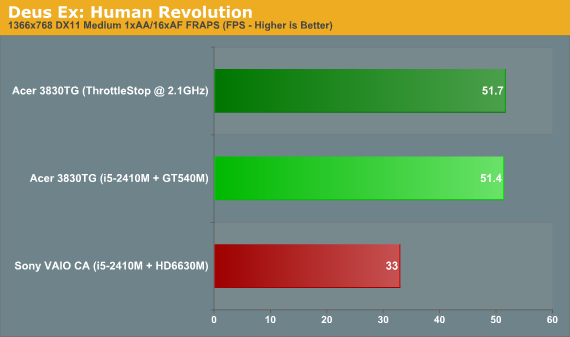
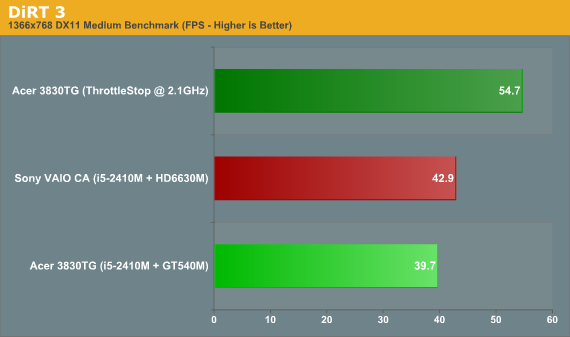
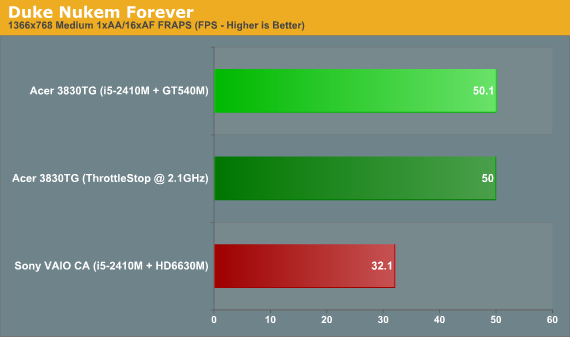
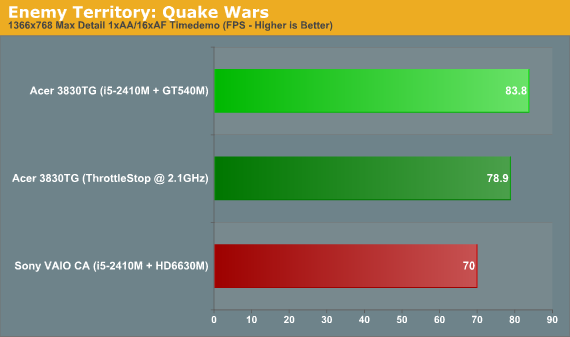

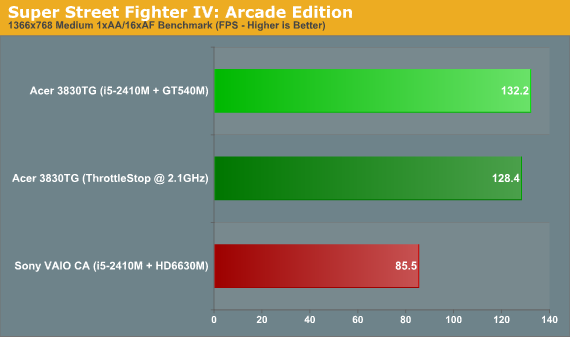
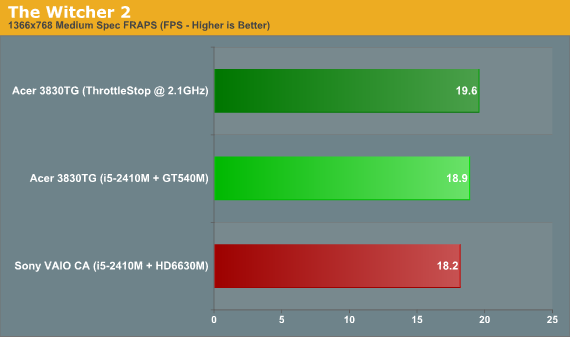
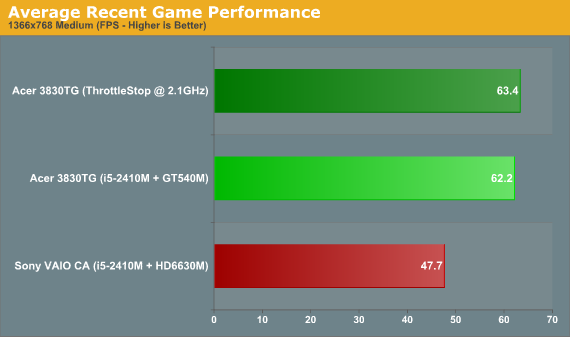
So here’s where things get interesting. In our current (soon to be deprecated) list of games on the previous page, the 6630M in the VAIO C generally equals the GT 540M in the Acer 3830TG. NVIDIA wins in Bad Company 2, Left 4 Dead 2, Mafia II, Mass Effect 2, and STALKER: Call of Pripyat by 4-14%; AMD counters by claiming wins in Civilization V (3%), DiRT 2 (1%), Metro 2033 (6%), StarCraft II (31%), and Total War: Shogun 2 (6%). Obviously, StarCraft II is the big difference, and it looks like the CPU throttling (or using ThrottleStop to set the CPU speed to 2.1GHz) accounts for a large portion of the difference. As we mentioned on the previous page, the Alienware M11x R3 averages out to 3.5% faster than the best the Acer can muster, and the Dell XPS 15 comes in 9% faster than the 3830TG, so if the CPU throttling weren’t present we’d expect the 3830TG to end up around 6% faster than the VAIO CA. Be that as it may, let’s just call it a tie between the GT 540M and HD 6630M and move on to our newer titles.
Looking at the recent releases (along with the OpenGL Enemy Territory: Quake Wars), the tables shift dramatically. The closest the VAIO C/HD 6630M gets is in The Witcher 2, where the Acer 3830TG/GT 540M still has an 8% lead. Elsewhere, NVIDIA leads by over 50% in Deus Ex: Human Revolution, Duke Nukem Forever, and Super Street Fighter IV: Arcade Edition. Rounding things out, DiRT 3 is 28% faster, ETQW is a 20% lead, and Portal 2 is 15% faster. Also worth pointing out is that three of the games in this list (DiRT 3, Deus Ex, and Portal 2) are promoted by AMD (and SSF4 is promoted by NVIDIA). Overall, in our recent titles the Acer leads the Sony by a not-insignificant 35% on average—and that’s with an Optimus laptop that we’re either running at a slower CPU speed, or potentially getting some CPU throttling. How much of the performance loss is caused by unoptimized drivers is unclear, but we suspect the 6630M with Catalyst 11.8 would fare a lot better.










91 Comments
View All Comments
tipoo - Tuesday, September 20, 2011 - link
"The bigger issue of course is that AMD needs to get their laptop partners—Sony in this case—to release regular driver updates, and to use up-to-date driver builds when laptops launch."AMD now lets you get laptop drivers from their own site, and they are always as up to date as the desktop ones. Unless Sony opted out of that for whatever reason?
OCedHrt - Tuesday, September 20, 2011 - link
These drivers do not work for switchable graphics. nVidia had the same issue before Optimus.orangpelupa - Wednesday, September 21, 2011 - link
the driver is work for switchable graphic.my acer laptop with switchable intel + HD Mobility 5650 is updateable.
use the 11-8_mobility_vista_win7_64_dd_ccc.exe
not the a few KB .exe auto detector from ATi. This app is useless.
but if failed to install using the main almost 100MB .exe, usually it stil can be isntalled using modded .inf.
just make sure to Switch to dGPU mode before running any installation driver.
orangpelupa - Wednesday, September 21, 2011 - link
modded inf and the download link for mobility 11.8 generic ATihttp://wp.me/pyhfN-m1
The0ne - Wednesday, September 21, 2011 - link
I wouldn't say useless as the full package download refuses to installed properly on my M17xR2 and the only way for the driver to work is for me to use their auto detector and downloader. This for some reason downloads a slightly different package (size is less I believe) but it works.mfenn - Tuesday, September 20, 2011 - link
Did you even read the article? Jarred mentioned that they did on several occasions. Hell, he even devoted an entire page to the issue!mczak - Tuesday, September 20, 2011 - link
I'm wondering if you can still "make your own driver". This is exactly what I did for a Thinkpad T400 with switchable graphics, since the provided driver was so old and buggy. The "monolithic" driver isn't really all that monolithic, it basically consists of a standard AMD mobility driver (which you just can download if you have the real download link) plus a standard intel driver in the same package. Though the .inf file needs to be hacked up.(So I used an old switchable driver to see what the .inf looked like, plus a new intel and amd mobility driver to make up the new version - worked quite ok except some driver signing warnings, and some bogus mux-switching upon suspend/resume with multimon though I don't think this worked before neither.)
I'd venture a guess and suspect this would still work with the muxless solutions, but it's a huge pain in the ass obviously and AMD really needs to fix this and just have drivers which work on all mobile gpus, the OEMs will NEVER get it right otherwise, they won't care if AMD gives them new drivers monthly or not they will simply not bother to supply updated drivers.
bjacobson - Tuesday, September 20, 2011 - link
even if they up to date, that's no guarantee that they're going to work for the first 6 or so months. I've never had much luck getting everything on AMD to work the first time-- crossfire with dual monitors doesn't work on 2x 5770 with Quake Wars : Enemy Territory (had to disable the 2nd display); alt-tab still doesn't work in Unreal Tournament 3 without crashing the game (not in crossfire, just 1x4890); and it took them several months after switching their user interface to that new one to package back in the under/overscan ability on the embedded graphics that came on the motherboard we used for our HTPC...just lots of stuff that's always 95% complete with 5% broken that ends up being really annoying.IE, I wouldn't be surprised if somewhere in between suspend, hibernate, plugging in an external monitor, and this dynamic GPU solution, that something won't work quite right for about 6 months...but that's just my gut speaking judging by what I've seen before. I'm a big fan of underdogs and still cheer for AMD, but I do have to say Nvidia's drivers (since about 8800GT which is as early as my experience goes) have simply worked with all those quirky setups we needed and didn't end up breaking later when installing an updated driver.
OCedHrt - Wednesday, September 21, 2011 - link
I've always had to overscan/underscan available as an option for integrated graphics for the last 2 years+. Yet I've always had problems with nVidia, especially on stability. I don't think the stability is always tied directly to the gpu and drivers.Aloonatic - Tuesday, September 20, 2011 - link
Is that just for more recent mobility radeon systems?Just the other day, I was looking to update a laptop with a 4570, but it wouldn't update anything other than the good old CCC.
(I was a Dell Studio 17, by the way :o) )